RBSE Class 12 Economics Board Paper 2018 English Medium are part of RBSE Class 12 Economics Board Model Papers. Here we have given Rajasthan RBSE Class 12 Economics Board Paper 2018 English Medium.
| Board | RBSE |
| Textbook | SIERT, Rajasthan |
| Class | Class 12 |
| Subject | Economics |
| Paper Set | Board Paper 2018 |
| Category | RBSE Model Papers |
Rajasthan RBSE Class 12 Economics Board Paper 2018 English Medium
Time: 3.15 Hours
Maximum Marks: 80
General Instructions to the Examinees
- Candidate must write his/her Roll No. on the question paper compulsorily.
- All the questions are compulsory.
- Write the answer to each question in the given answer book only.
- For questions having more than one part, the answers to those parts are to be written together in continuity.
-
Section Q. Nos Marks per question Word limit of answer A 1-10 1 10 Words B 11-18 2 20 Words C 19-27 4 30-40 Words D 28-30 6 250-300 Words - Question Nos. 28,29 and 30 have internal choices.
SECTION – A
Question 1.
Which economist for the first time used Micro and Macro terms in economics? [1]
Question 2.
What are the social costs? [1]
Question 3.
Production function shows relationship between which two variables? [1]
![]()
Question 4.
In which market form, the number of buyers and sellers are large? [1]
Question 5.
Give any two examples of intermediate goods. [1]
Question 6.
Write the definition of money. [1]
Question 7.
What is meant by overdraft? [1]
Question 8.
Write the formula to calculate marginal propensity to consume. [1]
Question 9.
What is meant by aggregate demand? [1]
![]()
Question 10.
Write the meaning of open economy. [1]
SECTION – B
Question 11.
What do you understand by utility? [2]
Question 12.
Explain the substitution effect with example. [2]
Question 13.
Clarify the difference between stock and flow. [2]
Question 14.
Mention two characteristics of national income. [2]
Question 15.
Distinguish between gross domestic product and gross national product. [2]
Question 16.
Explain the M, and M, concept of money supply. [2]
![]()
Question 17.
Describe two objectives of budget. [2]
Question 18.
Explain two benefits of cashless transactions. [2]
SECTION – C
Question 19.
Mention any four differences between microeconomics and macroeconomics. [4]
Question 20.
Give the meaning of indifference curve. Mention its three features. [4]
Question 21.
Explain the concept of markets demand with the help of demand schedule. [4]
Question 22.
Explain the concepts of average product and marginal product. [4]
Question 23.
Clarify the difference between gross investment and net investment. [4]
![]()
Question 24.
Explain four features of the monopolistic competition. [4]
Question 25.
Explain the marginal efficiency of capital with the help of diagram. [4]
Question 26.
If the marginal propensity to consume is 0.5, calculate the value of investment multiplier. [4]
Question 27.
Mention any four reasons for the need of international trade. [4]
SECTION – D
Question 28.
Explain the three stages of law of variable proportions with the help of diagram. [6]
OR
Explain the concepts of total fixed cost, total variable cost and total cost with help of a schedule.
Question 29.
Explain the determination of market equilibrium through demand and supply with the help of diagram. [6]
OR
What is the effect of simultaneous increase in demand and supply on equilibrium price? Explain with the help of diagram.
![]()
Question 30.
Define commercial bank. Describe any four functions of commercial bank. [6]
OR
Define central bank. Describe any four functions of the central bank.
Answers
Answer 1.
Ragner Frish.
Answer 2.
Social costs refer to the sacrifices and pains borne by the society during the production. For example-loss to health due to pollution, noise, dust, smoke, etc.
Answer 3.
Function refers to the quantitative relationship between two variables (independent and dependent variables). Therefore, production function describes the consequent relationship between the quantity of production (output) and the quantity of resources (inputs).
Answer 4.
In a perfect competition market.
Answer 5.
Purchase of thread and rubber by the producer.
Answer 6.
According to Hartley Withers, “Money is that commodity, by which we sell and purchase things”.
![]()
Answer 7.
A business class current account holder is provided the facility of obtaining more money than what is deposited in his account for a short time period which is known as overdraft.
Answer 8.
Marginal Propensity to Consume (MPC) = Change in Consumption (AC) / Change in Income (AY)
Answer 9.
At a given level of income an employment, the sum total of goods and services demanded in an economy in one year is known as aggregate demand.
Answer 10.
That economy in which there is no prohibition on export and import with other countries is known as open economy.
Answer 11.
The power or capacity of a good or service of fulfilling a requirement is known as utility. This means that the quality of fulfillment of requirement possessed by a good or service is known as utility.
Answer 12.
Substitution effect means that if a good becomes relatively cheaper, then it is substituted for a costlier good. For example- if the price of good X becomes cheaper than the price of good Y, then the cheaper good X is substituted in place of the costlier good Y, i.e. the demand of good X increases.
![]()
Answer 13.
Difference between Stock and Flow:
| Stock | Flow |
| 1. Stock is the measure of economic variable at a fixed point. | Flow is the measure of economic variable in a fixed time period. |
| 2. Stock is a fixed concept. | Variable is a fluctuating concept. |
| 3. There is no time period of stock. | There is time period in variable. |
| 4. Stock affects the flow. | Flow affects the stock in both direct and indirect forms. |
| 5. Property, workforce, capital, bank deposits, water from roof tank, etc. are examples of stock. | Income, cash flow, capital formation, interest on capital, leakage of water from the tank, etc. are examples of flow. |
Answer 14.
- National income is related to the economy of a country.
- National income is related to a fixed time period, which is normally a financial year (In India, it is from 1st April of the current year to 31st March of the next year).
Answer 15.
(a) The sum total of price increases made by all the producers in one year within the domestic boundary of a country is known as gross domestic product, while gross national product refers to the sum total of price increases made by the normal citizens of a country within and outside the domestic boundaries of a country.
(b) Domestic product is defined in context to domestic boundary. Therefore, it is a regional concept.
Answer 16.
M1 = C + DD + OD (Currency + Demand Deposits + Other Deposits)
M2 = M1 + Saving deposits in Post Offices and Banks
Answer 17.
- To present an appropriate description of income and wealth in the country.
- To enhance the economic development of the country.
Answer 18.
- Saving of time and money.
- Relief from keeping cash.
- Decline in pressure on banks.
- Decline in black marketing. (any two)
![]()
Answer 19.
Differences between Micro Economics and Macro Economics:
| Basis of Difference | Micro Economics | Macro Economics |
| 1. Scope | Micro economics performs the study of the problems of an individual, a firm, a family, an industry, etc. | Macro economics performs the study of total consumption, total exchange, total national income, etc. on the level of the entire economy. |
| 2. Assumption | Micro variables are assumed to be fixed for performing study under micro economics | Macro variables are assumed to be fixed for performing study under macro economics. |
| 3. Objective | Its main objective is distribution of resources in the best possible manner. | Its main objective is full utilization and development of resources. |
| 4. Major Problem | Price determination is the major problem of micro economics. | Determination of income and employment is the major problem of macro economics. |
Answer 20.
An indifference curve is a graph showing combination of two goods that give the consumer equal satisfaction and utility.
Features
- It is downward sloping.
- Indifference curve is convex to the origin.
- Each higher indifference curve depicts greater satisfaction.
- Two indifference curves cannot intersect each other. (any three)
Answer 21.
Market demand table is a tabular representation of the sum total of the quantity of goods demanded by all the consumers at various prices at a particular time period. Following is an example of a market demand table:
| Price (in rupees per kg) |
Quantity demanded by A (in kg) | Quantity demanded by B (in kg) | Quantity demanded by C (in kg) | Quantity Demand (A + B + C) (in kg) |
| 10 | 100 | 200 | 75 | 375 |
| 15 | 75 | 150 | 60 | 285 |
| 20 | 50 | 100 | 45 | 195 |
| 25 | 25 | 50 | 30 | 105 |
Answer 22.
(a) Average Product (AP). Average product is the total product divided by the units of variable factor. It is also known as per unit product.
Average Product = Total product/ Variable factors, Labour input AP = TP /QL
(b) Marginal Product (MP)-Marginal product refers to the change which takes place in total production while using an additional unit of variable factor (labour). This is the quantity produced by an additional unit. Marginal Product = Change in total production / Change in the input of variable factor, labour MP = ΔTP / ΔQ
![]()
Answer 23.
Gross Investment– Expense done by the producer on capital goods in a fixed time period (usually one year) is called gross investment. For example- increase in the total quantity of new machine, new building, new dam, new electricity plant, etc. Expense done on old machine, old building, old dam, old canal is also included in gross investment.
Net Investment– This is basically gross investment minus the amount of wear and tear in physical capital goods in a fixed time period (usually one year). Investment which is obtained after deducting the price depreciation, i.e. wear and tear of physical capital goods is known as net investment.
Answer 24.
Features of monopolistic competition:
- More number of sellers or firms- In monopolistic completion market, the number of sellers is very large, but the share of an individual seller in total market production is very less. Due to this, his activities do not affect other firms.
- Product differentiation- In imperfect competition or monopolistic competition, goods produced by various producers are not identical, and there is some. difference between them. This difference can be real or fictitious, which may be in the form of packing, shape, colour or appearance or through advertisement. Due to this, products sold by different sellers are not fully substitutive.
- Entry and exit of firms- There is free entry and exit of firms in this market. This means that any firm can enter in the industry, and similarly, any firm can also exit from the industry.
- Incomplete knowledge about the market- The buyers do not have complete knowledge about this market. Due to this, the sellers become successful in charging different prices for their products. They do this by product differentiation.
Answer 25.
Investment is required in an economy to make increase in employment and to fulfill the increasing requirements. Profit
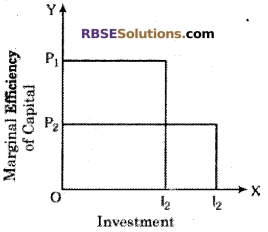
which is derived from the investment of one additional unit of capital is known as the marginal efficiency of capital.
Answer 26.
K = 1/1 – MPC = 1/1-0.5 = 2.
![]()
Answer 27.
Need of International Trade: We can understand about the need of international trade with the help of the following points
- All countries are not capable of producing all types of goods, therefore they have to depend upon others for the fulfillment of their needs.
- There is unequal distribution of resources such as fertile soil, mineral wealth, forest wealth, etc. in the world. The climate is also unequal. Substitution between the factors of production is not complete. Therefore, every country specializes in the production of such goods whose resources are available in the country in abundant amount. Their production cost reduces by this. The country exports these goods in order to earn profit. On the contrary, it imports those goods from other countries, whose resources are less available and whose prices are high.
- Modern technology is obtained through international trade which helps in the development of underdeveloped and backward countries.
- Due to international trade, competition increases among domestic industries also, and in order to earn more profit from international trade, they increase both, the quality of their product and the quantity of sales.
Answer 28.
Law of Variable Proportions Traditional economists regarded the law of diminishing returns to be a fundamental law which broadly applies in the field of production. Modern economists call it as the law of variable proportions. According to them, the law of diminishing returns is merely a stage of the law of variable proportions.
Definitions of the Law
- According to Prof. Marshall, “An increase in the capital and labour applied in the cultivation of land causes, in general, a less then proportionate increase in the amount of produced raised, unless it happens to coincide with an improvement in the art of agriculture.”
- According to Prof. Stigler, “As equal increments of one input are added, the inputs of other productive services being held constant, beyond a certain point, the resulting increments of produce will decrease i.e., the marginal product will diminish.”
- According to Lipsey and Chrystal, “The law of variable proportions states that as the quantity of one factor is increased, keeping the other factors fixed, the marginal product and average product of that factor will eventually decline in the end.”
It is clear from the above definitions, that as the quantity of one factor is increased, keeping the quantity of other factors fixed, the marginal product and average product will eventually decline.
Interpretation of the Law- According to the law of variable proportions, when the quantity of variable factor is increased while keeping the other factors fixed, then total product, average product and marginal product change at a different rate. This condition has been depicted in the table given below:
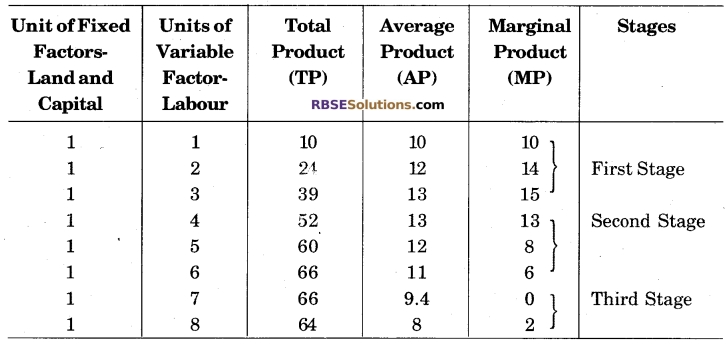
The three stages of variable proportions are :
First Stage- In this stage, along with increase in the quantity of variable factor labour, total product, average product and marginal product all three increase continuously. This is the stage of the law of increasing returns. In this stage, due to increase in the quantity of labour, the fixed factors are used in a more effective manner. Due to this, per unit cost declines.
Second Stage- This stage starts from the fourth unit of labour. In this stage, total product increases at a declining rate. Average product declines after remaining fixed and marginal product declines continuously. In this stage, consistency of the factors comes to an end.
Third Stage- This stage starts from the seventh unit of labour, in which coordination between the factors starts deteriorating and marginal product becomes negative. Total product also starts declining from the eighth unit.
Second stage is the best for production. A producer cannot maximize his profit while remaining in the first and the third stage. He would like to stay at the equilibrium point in the second stage itself. These three stages are clarified with the help of the following diagram.
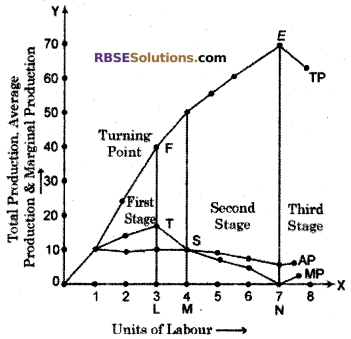
It is clear from the above graph, that average product increase from point O to L. This is the first stage of production. The second stage lasts from L to N and beyond N it is the third stage. No producer would like to remain in the third stage because in this stage, the production starts decreasing in place of increasing. He would like to remain in the second stage itself.
![]()
OR
(1) Total Fixed Cost (TFC): In the process of production, expense which is done on fixed factors is known as total fixed cost. Total fixed cost is not related to the quantity of production. This cost remains fixed at all the levels of production. It is related to the size of the plant of the firm, for example- expense done on building, expense done on machinery, insurance, etc. In other words, total fixed cost refers to the difference between total cost and total variable cost.
The following formula is used to calculate this
TFC = AFC x Q
TFC = TC – TVC
This can be clarified through the following table:
| Quantity of Production (Q) | TFC |
| 1 | 100 |
| 2 | 100 |
| 3 | 100 |
| 4 | 100 |
| 5 | 100 |
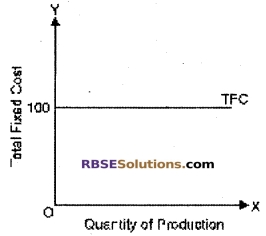
(2) Total Variable Cost (TVC): These are those costs, which change along with the quantity of production, i.e. these costs decline along with decline in production and they become zero when the production is zero. These are also known as prime or conversion cost. For example expense done on wages of labourers, raw material, electricity, etc. In other words, total variable cost refers to the difference between total cost and total fixed cost.
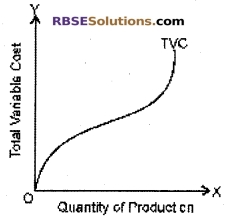
The following formula is used to calculate this
TVC = TC – TFC
TVC = AVC x Q
This can be further clarified with the help of the following table.
| Quantity of Production (Q) | TVC |
| 1 | 100 |
| 2 | 160 |
| 3 | 200 |
| 4 | 220 |
| 5 | 260 |
Initially, total variable cost increases at a declining rate due to the application of the law of increasing returns, after that, due to the application of the law of constant returns, they increase at a fixed rate, and in the end, due to the application of the law of diminishing returns, they increase at an increasing rate. (3) Total Cost (TC): Total expense done
on the production of a goods in short time period is known as total cost. Total cost is the sum total of fixed cost and total variable cost. The following formula is used to calculate total cost
TC = TFC + TVC
TC = AC x Q
This can be further clarified with the help of the following table and graph
| Quantity of Production (Q) | TFC | TVC | TC |
| 0 | 100 | 0 | 100 |
| 1 | 100 | 100 | 200 |
| 2 | 100 | 160 | 260 |
| 3 | 100 | 200 | 300 |
| 4 | 100 | 220 | 320 |
| 5 | 100 | 260 | 360 |
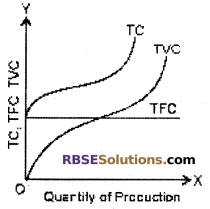
In short term, change in total cost takes place due to change in total variable cost only because total fixed cost remains unchanged in the short term.
![]()
Answer 29.
Equilibrium of Demand and Supply- From demand aspect, it is known that the marginal utility of a goods is the highest level of its price, while from supply aspect, it is known that the marginal cost of a goods is the lowest level of its price. The equilibrium price of a goods is determined at that point between these two levels at which demand and supply of the goods is equal. The buyer wants to pay minimum price for a goods, while the seller wants to obtain maximum price. Therefore, the actual price is determined at the equilibrium point of demand and supply, on which both the buyer and the seller are satisfied. Price determined at this equilibrium point is known as equilibrium price and the quantity of the goods determined at this price is known as equilibrium quantity.
Determination of Equilibrium Price
| Price of Good X | Demand of Good X | Supply of Good X |
| 5 | 25 | 2 |
| 10 | 22 | 5 |
| 15 | 18 | 9 |
| 20 | 15 | 15 |
| 25 | 9 | 23 |
| 30 | 6 | 31 |
Interpretation of the table- It is clear from the above table that when the price of good X increases, its demand decreases, while the supply of the good increases. In the given table, the units of demand and supply are the same, i.e. 15 units each at equilibrium price 20. Therefore, 20 will be regarded as the equilibrium price.
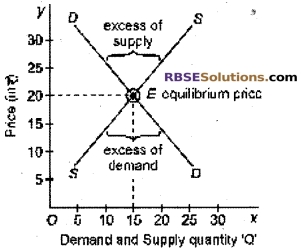
Interpretation of the graph- In the above graph, demand and supply of the good is shown on the Ox axis while the price of the gods has been shown on the Oy axis. DD curve depicts demand while SS curve depicts the supply of the goods. Both demand and supply curves intersect each other at point E. Therefore, the price of the goods is determined at OP. OQ quantity of the goods is the equilibrium quantity and the price determined at point E is the equilibrium price. When the price of the goods is 20, demand and supply of the goods both are equal at this price, i.e. 15 units each. Therefore, E is the equilibrium point at which both demand and supply are equal.
OR
In the diagram, SS is the actual supply curve and DD is the actual demand curve. While looking at the graph, it is clear that when both the demand and supply curve shift on the right then their new equilibrium point is formed at point E, and the new quantity increases to q, while there is no change in price P. Therefore, it can be said that there will be no change in equilibrium
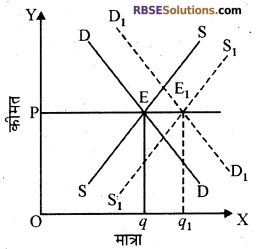
price but the equilibrium quantity will increase if both the demand and the supply curve shift in equal proportion to the right. If this shift of both the curves takes place in unequal proportion, then there will be change in both price as well as in quantity.
Answer 30.
In India, commercial banks refer to such banks which perform all the general banking functions and which are regulated and controlled according to the Banking Regulation Act, 1949. Modern banking developed in Europe and later it spread across the world.
Definition of Bank: There are various definitions about bank. Following are the major ones among them:
- According to Oxford Dictionary, “Bank is that institution which protects the money obtained by its customers. Its major function is to make payment of its drafts. Its profit is obtained from the money which is deposited by its customers.
- According to the Banking Regulation Act, 1949, “A Banking company is one which performs the business of banking. It means the accepting, for the purpose of lending or investment, of deposits of money from the public, repayable on demand or otherwise, and withdrawable by cheque, draft, order or otherwise.”
Major Definitions given by Economists
- According to Hart, “Banker refers to a person carrying on a business of receiving money, and collecting drafts for customers subject to the obligation of honoring cheques drawn upon him from time to time by the customers to the extent of the amounts available on their current accounts.”
- According to Kinley, “Bank is an establishment which makes to individuals such advance of money as may be required and safely made and to which individuals entrust money when not required by them for use.”
On the basis of the above definitions, a simple and brief definition of bank can be given in the following manner:
“Bank is such a financial institution which performs the business of money and credit.”
Functions of Commercial Banks:
(1) Accepting Deposits: A major function of commercial banks is to accept deposits of its customers. Banks accept deposits from the people and arrange sufficient financial resources. Banks provide interest also to their customers on these deposits. In order to attract deposits from people, banks provide them the facility of opening various types of accounts. Following are the major types of accounts which can be opened in a bank:
- Saving Account
- Fixed Deposit Account
- Current Account
- Recurring Deposit Account
- Prime Ministers Public Money Account
(2) Granting Loans: Second most important function of commercial banks is to provide loans to their customers on demand. On one hand, banks provide loans to businessmen and industrialists, and on the other hand, they also provide loans to normal customers for construction of houses, purchase of vehicles, for the education of children and for marriage purposes. Commercial banks keep a fixed percentage of their deposits in the form of liquid fund and provide rest of the amount in the form of loans to their customers. Interest charged on loans is greater than interest provided on deposits.
Banks provide loans in the following forms:
- Loan or Advance
- Cash Credit
- Overdraft
- Discounting Bills of Exchange
(3) Agency-related Functions: Banks also work in the form of agents on behalf of their customers. In order to perform these functions, a customer has to direct the bank in written form. Some functions out of these are performed by the banks free of cost, while it charges fee for several other functions. Following are the major works included in this category:
- Collection of cheques and bills
- Making payment of cheques and bills
- Making payment on behalf of the customers
- Receiving payment on behalf of the customers
- Performing the work of underwriting
- Performing sale and purchase of shares, debentures and government bonds on behalf of the customers
- Transferring money
- Functioning in the form of financial advisor
- Working in the form of trustee,
- Issuing letters of reference.
(4) General Utility Functions: Apart from the above mentioned functions, banks also perform several general utility functions, which are as follows:
- Facility of lockers
- Arrangement of foreign exchange
- Facility of Travelers cheque
- Credit creation
- Arrangement of public loans
- Functioning as a clearing house
- Collecting and publishing information
- Facility of credit card
- Facility of internet banking
- Facility of mobile banking
- ATM facility.
OR
Central bank is the supreme bank of every country. It regulates currency and credit. Following are the major definitions of central bank:
- (i) According to A. C. L. Day, “Central bank is that bank which helps to control and stabilise the monetary and banking system.”
- According to Samuelson, “Central bank is a bank of bankers and its duty is to control the monetary base and through control of this ‘high-powered money’ to control the community’s supply of money.”
- In words of Hartrey, “Central bank is the bank of banks because it functions as the final lender for all other banks.”
- According to Shaw, “A central bank is a bank which controls credit in the country.”
Functions of Central Bank
- Issuing Currency: Issuing currency is an important function of the central bank. It performs the work of issuing currency while keeping in mind the financial requirements of the country. It enjoys monopoly in this work.
- The Bank of Banks: Another function of the central bank is to keep control on other banks so that various banks function according to the policies of the government.
- Banker of the Government: Central bank also functions in the form of banker of the government. It deposits money on behalf of the government and makes payments also. It also performs the work of providing advice to the government in context to financial matters. Along with this, it also makes arrangement of loan for the government.
- Guardian of Foreign Exchange Reserve: The central bank of the country maintains the reserve of foreign currency and it deposits foreign exchange obtained from various sources and also provides it on behalf of the government as per requirement. It also performs the work of keeping the exchange rate stable.
- Central Clearing House: This bank performs debit and credit of mutual transactions between commercial banks in the accounts and thus initiates the transactions without cash.
- Regulation and Control of Credit: Central bank also performs the work of regulating and controlling the amount of credit in the country. For this, it uses a tool known as Monetary Policy.
We hope the given RBSE Class 12 Economics Board Paper 2018 English Medium will help you. If you have any query regarding Rajasthan RBSE Class 12 Economics Board Paper 2018 English Medium, drop a comment below and we will get back to you at the earliest.